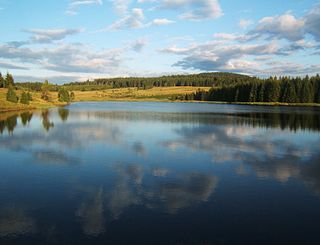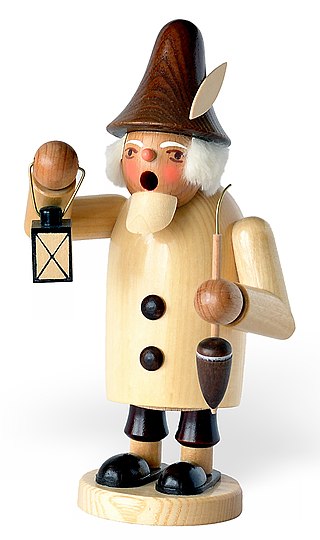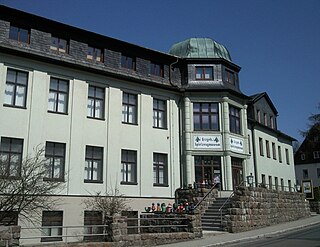
A nutcracker is a tool designed to open nuts by cracking their shells. There are many designs, including levers, screws, and ratchets. The lever version is also used for cracking lobster and crab shells.

The Ore Mountains lie along the Czech–German border, separating the historical regions of Bohemia in the Czech Republic and Saxony in Germany. The highest peaks are the Klínovec in the Czech Republic at 1,244 metres (4,081 ft) above sea level and the Fichtelberg in Germany at 1,215 metres (3,986 ft).

An Advent calendar is used to count the days of Advent in anticipation of Christmas. Since the date of the First Sunday of Advent varies, falling between November 27 and December 3 inclusive, many reusable Advent calendars made of paper or wood begin on December 1. Others start from the First Sunday of Advent and thus include the last few days of November that begin the liturgical season of Advent.

Christmas lights are lights often used for decoration in celebration of Christmas, often on display throughout the Christmas season including Advent and Christmastide. The custom goes back to when Christmas trees were decorated with candles, which symbolized Christ being the light of the world. The Christmas trees were brought by Christians into their homes in early modern Germany.

The Striezelmarkt in Dresden is one of the first genuine Christmas markets in the world. Founded as a one-day market in 1434, it celebrated its 585th anniversary in 2019. Its 240 stands attract about 3 million visitors from all over the world. The annual market lasts throughout the Advent season until Christmas Eve.

A Christmas decoration is any of several types of ornamentation used at Christmastide and the greater holiday season. The traditional colors of Christmas are pine green (evergreen), snow white, and heart red. Gold and silver are also very common, as are other metallic colours. Typical images on Christmas decorations include Baby Jesus, Father Christmas, Santa Claus, and the star of Bethlehem.

Johanngeorgenstadt is a mining town in Saxony’s Ore Mountains, 17 km south of Aue, and 27 km northwest of Karlovy Vary. It lies in the district of Erzgebirgskreis, on the border with the Czech Republic, is a state-recognized health resort (Erholungsort), and calls itself Stadt des Schwibbogens. Its population decline since the 1950s has been extremely severe, falling from 45,000 residents in 1953 to only about one twelfth of that now.

The 140-kilometre-long road, the Silver Road is the first and longest holiday route in the German Free State of Saxony. Against the background of the importance of mining in the history of Saxony, the road links those sights and tourist attractions of the Ore Mountains and its foreland that relate to the centuries-old mining and smelting industries of the region.

Christmas pyramids are Christmas decorations that have their roots in the folklore and customs of the Ore Mountain region of Germany, but which have become popular internationally. They comprise a decorated pyramidal outer frame with candle holders and a central carousel with a rotor at the top which is driven by warm air from the lit candles. The carousel is decorated with nativity scenes and other Christmas figures such as angels and wise men, as well as worldly motifs such as mining folk and forest scenes.

Geyer is a town in the district of Erzgebirgskreis, in Saxony, Germany. It has a population of about 4,000.

The town of Seiffen is located in the district of Erzgebirgskreis, which is in the central south of the Free State of Saxony in Germany. The earliest record of the town dates to 1324 when it was referred to as "Cynsifen".

A Schwibbogen is a decorative candle-holder from the Ore Mountains region of Saxony, Germany. The first metal schwibbogen was made in 1740 in Johanngeorgenstadt. The early candle arches consisted of a single forged piece of black metal which could be painted. The number of candles varies with the size of the arc, the original design holding eleven. In the UK candle arches or candle bridges are marketed, often just consisting of a simple wooden stepped arch with 7 electric candles. These are not strictly schwibbögen.

The Räuchermann, erzgebirgisch Raachermannel is an incense smoker, the invention of toy makers in the Ore Mountains, used to burn down cone incense, known as Räucherkerzchen.

The Ore Mountain Toy Museum in Seiffen is an internationally known museum of Ore Mountain toys and Ore Mountain folk art. It was opened in 1953 in Seiffen. In 1973 it was joined by the Ore Mountains Open-Air Museum, a folk art and local historic museum with 14 houses typical of the Ore Mountains before 1900 on the edge of the toy village.

Ore Mountain folk art is a well-known form of highly artistic wood carving from East Germany. It encompasses the diverse forms of expression of the creative work beyond the classical or the modern arts, and in particular the production of figures, sculptures and paintings. In a broader sense, the people's poetry, literature, and the Ore Mountain songs are in itself the folk art. The Ore Mountains claim to be the largest, enclosed folk art area in Germany.

The history of wooden toymaking in the Ore Mountains is closely bound to regional circumstances. The Ore Mountains are located in Central Europe on the border between Germany and the Czech Republic. For many centuries it was a countryside in which the local population eked out a hard existence from the land. Long and harsh winters restricted agriculture; in addition the region had very poor communications. With the onset of ore mining a new line of commerce developed, but the hard labour and high risks involved meant that it was only work for young and strong men. Many were injured or died as a result of accidents. The miners rose early in the morning whilst it was still dark in order to go to work and did not return home again until late in the evening after dark. From those times comes a custom that has survived to the present day, the practice of placing lights in the window. These lights were intended to show the miners the safe way back to the homes of their families.

The Miners' Parade is a parade traditionally held in places in Germany where ore was and is smelted. It was and is a public event held by a community or corporation whose employment is linked to mining and smelting. It is usually known in German as a Bergparade, but also as a Berg- und Hüttenparade. It takes place as one of the highlights of a festival. The Miner's Parade is a special form of procession which is organised to march past important dignitaries or which is organized for such high-ranking individuals.

Nutcracker dolls, also known as Christmas nutcrackers, are decorative nutcracker figurines most commonly made to resemble a toy soldier. In German tradition, the dolls are symbols of good luck, frightening away malevolent spirits. While nearly all nutcrackers from before the first half of the 20th century are functional, a significant proportion of modern nutcrackers are primarily decorative, and not able to crack nuts. Nutcrackers are also a part of German folklore, serving as protectors of a house.

Christmas traditions include a variety of customs, religious practices, rituals, and folklore associated with the celebration of Christmas. Many of these traditions vary by country or region, while others are practiced in a virtually identical manner across the world.

Christmas angels are small wooden figures portraying angels often playing an instrument. They can be arranged to an entire orchestra. The origins of artistic angel carving lie in the Ore Mountains where the angels are an integral part of Ore Mountain folk art.






















